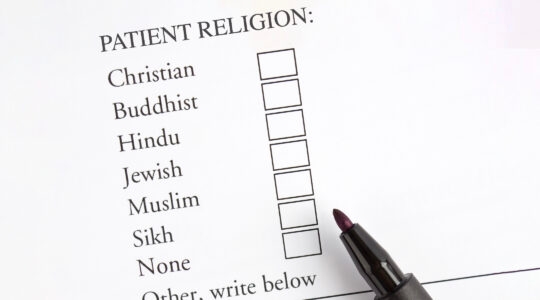When I was hired last summer as the executive director of Beth Am Synagogue in Baltimore, my new congregants, observing that I knew a little something about theater, clamored for me to take a role in the shul’s annual Purim play. And thus, despite having almost no acting experience, I’ve found myself spending Sunday afternoons this month dressed in a puffy white shirt, ruffle (made of coffee filters strung together) around the neck, slouchy, colorful hat and black yoga pants and boots for my cameo in “Something Treif,” a takeoff on the Shakespeare-inspired Broadway musical, “Something Rotten.” I could not refuse; the Beth Am Purim spiel is such a major event that the set from last year’s production has remained up all year, where it forms the backdrop for our Shabbat services.
Cantor Janet Leuchter has written that the Purim play is the “only genuine folk theater that has survived a thousand years in European culture.” During the Renaissance, she has found, the spiel was inspired by a wide range of biblical stories — sometimes from the Book of Esther, but also commonly based on the selling of Joseph into slavery, the triumph of David over Goliath or the Binding of Isaac. Performed by groups of yeshiva students or amateur musicians both in courtyards and in the homes of the wealthy (following the festive Purim meal), the spiels often contained bawdy and scatological elements, causing them to be periodically banned by the rabbis. But the practice persisted, and ultimately took on new life in America, where the play became a staple of synagogue life, melding Jewish and American culture in often breathtakingly creative ways.
Passover is a much more popular Jewish observance than Purim is. But is Purim actually the quintessential American Jewish holiday?
Last year it seemed as if almost every shul was doing a spoof of “Hamilton” for Purim. But this year, as a roundup of Conservative synagogues shows, there is a diversity of themes, and many of the plays are inspired not just by Broadway shows, but by pop music, books and movies. Congregation Beth Israel in Vancouver, B.C., is doing “Shpiel Over Troubled Water,” based on 22 Simon and Garfunkel tunes. Congregation Rodeph Sholom in Tampa is essaying “A Very Potter Purim.” Kehillat Ma’arav in Santa Monica, Calif., is doing “Rocky Hora,” based on “The Rocky Horror Picture Show.”
Some congregations are integrating the Purim play into either the service or the Megillah reading. When Congregation Beth Shalom in Seattle puts on a Beatles-inspired “We All Daven in a Yellow Submarine” this year, they will be hard-pressed to top last year’s “West Side Maariv,” in which the entirety of the evening service was put to Leonard Bernstein melodies and Jerome Robbins-style choreography. And Jason van Leeuwen, who serves as both a rabbi and a cantor at Temple B’nai Hayim in L.A., inserts his own spoofs on songs by Queen and Madonna inbetween the books of the Megillah in order, he told me, “to incentivize the old and the young to hear the entire Megillah.”
However, just as the Book of Esther has a darker undertone, some Purim plays are more than just simple parodies. Leanne Schy wrote this year’s Purim spiel for Congregation Beth Ami in Santa Rosa, Calif., a town that was devastated by wild fires last October; three congregants who appeared regularly in the annual production lost their homes. Her new work, “Purim of Love,” commemorates the 50th anniversary of the “Summer of Love” in San Francisco; its Esther, who comes from the last Jewish chicken ranch in Sonoma County, seeks fame and fortune in the big city, San Fran Shushan.
Ironically, one group of Jews that is most fervent in its rejection of American culture, the Bobover chasidim, is renowned for its Purim spiels, which — performed, of course, entirely by men — have employed cross-dressing of various kinds to send up sexy women, cowboys, Native Americans, African Americans, Arabs and any other group that they can think of. The late Dr. Rabbi Alan Miller, the practicing psychoanalyst who led the Society for the Advancement of Judaism (SAJ) on the Upper West Side, was fond of saying that Purim is the one day of the year when Jews can pretend not to be Jewish. But do most American Jews cherish that fantasy at all?
Purim may not be widely known outside of the Jewish community, as one sees in Christopher Guest’s 2006 film, “For Your Consideration,” a satire on Hollywood — and on Purim, as a “minor” Jewish holiday — shows. (It’s a spoof of a fictional Hollywood movie, “Home for Purim.”) Purim may not even be widely observed among non-synagogue going Jews. After all, as Rabbi Moshe Waldoks has written, Passover is about a communal act of liberation while Purim is about the freedom of the individual. What could be more American than that?
Ted Merwin, who is the executive director of Beth Am Synagogue in Baltimore, covers theater for the paper. His column appears monthly.
The New York Jewish Week brings you the stories behind the headlines, keeping you connected to Jewish life in New York. Help sustain the reporting you trust by donating today.




